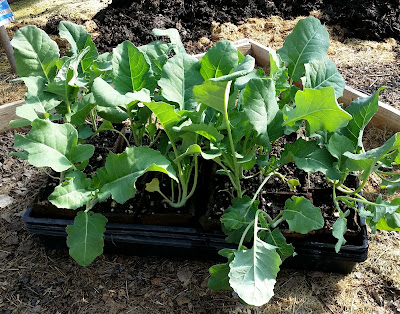Update: January 2025: We had such good results from this experiment the past two years that we've already started some seeds this year. Every year is different but we hope to have bounteous, early crops to show for our efforts again this spring.
(originally published - May 2023). Last year (2022) we experimented with starting seedlings, to be transplanted to other beds, right in our greenhouse raised beds. This worked quite well for several crops including: lettuce, broccoli, kale, collards, onions and cabbage. They are all plants that transplant easily and will germinate in relatively cool soil. These seedlings were started in rows with seeds planted every 1/2" or so.
 |
Chris starting seeds directly in greenhouse raised beds.
|
The advantage of this, over starting seeds in tofu-containers (below) (LINK) and "potting them up" to larger six-packs or pots is that it's easier to keep the seedlings uniformly watered and their roots are less likely to get overcrowded. The disadvantage is that, without a bottom-source of heat (electric mats), heat-loving plants like peppers or tomatoes may not germinate in the cooler soil. So, we'll still use heat mats for them.
 |
Seedling
starts in tofu containers. We drill holes in the bottom for drainage.
This is the way we used to start all our seedlings. These are then potted-up into larger pots.
|
 |
With our new method, as long as the soil is warm enough, we save time and effort and the roots of the seedlings have much more room to grow than if they were in tofu containers.
|
Once the seedlings germinated, and grew large enough, we carefully
transplanted them into larger pots, or directly into another
greenhouse-raised bed.
 |
Lettuce plants started in greenhouse raised beds and transplanted to another raised bed to grow to maturity,
|
Over the years, our raised bed soil has become a perfect medium for seed-starting. We can use it to fill pots and transplant starts into those pots to grow them out for later transplanting outside:
 |
Beautiful, healthy broccoli plants, started from seed in raised beds and transplanted into pots using soil from our raised beds.
|
This year, we are taking this experiment one step further. Chris decided to see if he could germinate some of the same kinds of seedlings, using this same method but in mid-January. (This is about a month earlier than what's suggested in our local planting guides!) So far, things are looking good.
 |
Chris planting seeds on January 13, 2023. He planted: three kinds of lettuce, bunching onions, Sweet Spanish, Burgundy Red and Cippolini onions, Toscana kale, chard and arugula.
|
 |
Because we're regularly getting nighttime temperatures in the low 30'S F and high, daytime temps have been in the 40's to 50's, Chris experimented by putting black plastic bags over the seedlings for several days before they emerged above ground. This raises the soil's temperature whenever the sun is out, and holds the heat in at night. Seeds need a minimum temperature to sprout but don't need light until their first leaves emerge from the ground.
|
 |
| Arugula seedlings (from seed we saved ourselves!) emerged after just five days. Chris checked the seedlings daily and, as soon as the first leaves began to show he removed the black plastic. The lettuce-seedlings emerged just a few days later. (As of January 25, everything has germinated except the onions and the
chard. Either the soil isn't warm enough or the seed isn't viable. We
shall try and plant them again and either wait till the soil is warmer,
or use heat mats for bottom heat.) |
 |
| Once up, the seedlings need light but also appreciate protection from cold nights. Here we've covered them with re-purposed plastic lids found at the recycling center! |
So far, our early-planting experiment seems to be working well. It's always a gamble getting seeds started this early but, since we have plenty of seed, if even a fraction of the plants grow to maturity, it will be worth it.
Update - May 2023: Here are some pics for how these experiments in early seed-starting in raised beds have fared...
 |
This lettuce was all started from seed in raised bed
'nurseries' as described above; then transplanted at proper spacing to
mature. These lettuce seedlings were started in mid-January. We began eating individual leaves off the heads beginning in March which
provided plenty of these fresh greens for us and our volunteers. Here, April 17th, Chris is seen selectively harvesting alternate heads to share at the Food Bank (so the remaining heads have more room to grow).
|
 |
Here is a picture of the same bed on April 24th. That's 'Slo-bolt' lettuce on the left, potato leaves beginning to appear in the center row and Chris planting Sweet Spanish onions on the right.
|
 |
Here are two boxes of lettuce, harvested and ready to be donated, in front of our Ark greenhouse. As of early May, the two greenhouses have yielded over 60 pounds of the most beautiful, tender, tasty lettuce imaginable! A successful experiment, wouldn't you say!
|














Another beautiful article. You have inspired me! Thank you!💗💗💗😊
ReplyDeleteThanks, buddy! happy growing :-) - Llyn
Delete